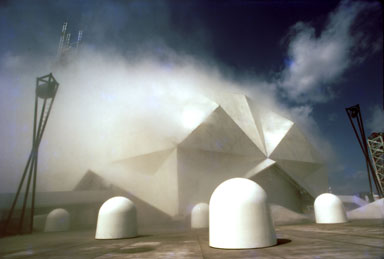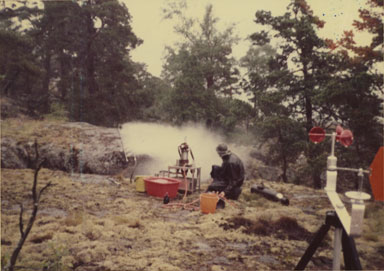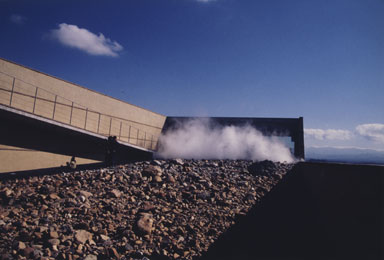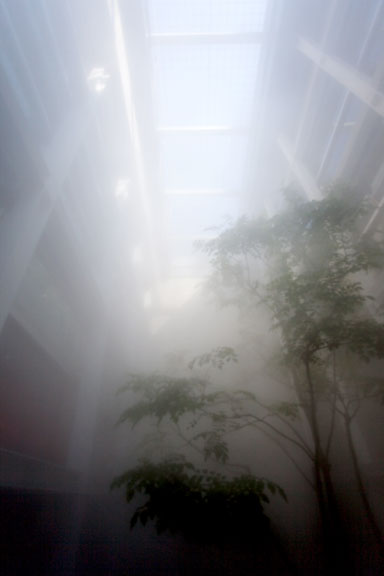While browsing around on the Internet, I found the remnants of this exhibition that took place in Yamaguchi Center for the Arts and Media in Tokyo back in 2010. To my big ignorance, I didn't know the work of Fujiko Nakaya dating back from the 1970ies. Now I do and I can see how far Blur, Diller & Scofidio's famous building (during Expo.01 in Switzerland back in 2001), was pushing Nakaya's ideas one step further/bigger.
Via Yamaguchi Center for the Arts & Media
-----
Artistic environmental spheres formed by fog, light and sound
Large-scale project unveiled simultaneously in three public spaces in and around YCAM
The upcoming CLOUD FOREST exhibition at the Yamaguchi Center for Arts and Media [YCAM] presents examples of newly discovered environmental creation, realized with an "artistic environments" themed fusion of artistic expression and information technology. Currently on show in three different public spaces in and around YCAM will be a large-scale collaborative project featuring "fog sculptures" by Fujiko Nakaya, an artist whose works have gained much attention at various occasions in Japan and overseas, along with the original light and sound art of Shiro Takatani.
These commissioned installations conceived in-residence at YCAM combine artificial fog, sunlight and sound, orchestrating with the help of originally developed devices and responding to changing weather conditions a variety of impressive sceneries. Visitors can experience transformations in their perception as they interact with artworks incorporating information technology while walking in the fog in the patios or surrounding park. While introducing and reevaluating foresighted art and science projects originally presented at the EXPO'70 Osaka, which eventually inspired this new project, the exhibition anticipates the future of environmental creation, "informational spheres" of tomorrow, and possible creative quests through art.
Related events
Opening events
Demonstrative Performance
August 7 (sat) 19:00 - 20:00
Venue: Foyer, Patios Admission free
Artists: Fujiko Nakaya, Shiro Takatani, softpad (Takuya Minami, Tomohiro Ueshiba, Hiroshi Toyama) In addition to Fujiko Nakaya and Shiro Takatani, the members of Kyoto-based art/design collective softpad, who took charge of the sound design for this exhibition, participate in a special experimental live performance incorporating the fog, light and sound installations in the patios and foyer.
Artist Talk
August 8 (san) 14:00-16:00
Venue: Studio B Admission free
Guests: Fujiko Nakaya, Shiro Takatani Moderator: Akira Asada
Artists involved in this exhibition appear as special guests in a casual talk session that gives them the opportunity to introduce their works. Moderator will be Akira Asada, a specialist in the field who is familiar with each artist's endeavors to date. While referring to the work of E.A.T. at the 1970 Osaka Expo's Pepsi Pavilion, which inspired this project in the first place, the artists will look back at such trailblazing achievements as Nakaya's "fog sculptures" and David Tudor's soundscapes originally presented at the Expo, and discuss the developments and prospects now, four decades later.
* There will be guided gallery tours offered during the period of the exhibition. Please check the exhibition website for more information on additional event.
Cloud Forest
Prospects of art-inspired new environmental creation
Rather than addressing "environmental" issues only from an ecological point of view, this "artistic environmental spheres" themed exhibition focuses on the mutual relationships between natural, social, mental and informational environments. Aiming to provide a stage for such diverse aspects of the subject matter to function as interfaces for each other, CLOUD FOREST pursues a contemporary form of environmental creation triggered off by transformations in human perception. The shifting perceptual experience of interacting with artworks incorporating information technology and YCAM's architectural characteristics makes the visitor aware of spatial transfigurations, and ultimately commands ideas related to "environments" of the future.

Fujiko Nakaya "Fog Sculpture #47773" Pepsi Pavilion Commissioned by Experiments in Art and Technology (EXPO' 70, Osaka, Japan 1970). Photo: ©Takeyoshi Tanuma
Environment as an art form
This exhibition is based on a definition of "environment" as a compound of mutually generative, penetrative and reflective areas. While there have been various movements in the past that proposed environments as stages for or components of art, such as land art or earth art, this exhibition aims to explore the creative aspects of media art for possible new forms of "environments". Think of it as an attempt to generate with the help of information technology open environments embracing multiple interlinked, mutually "environmental spheres". In this day and age, the concept of "environments" manifested through spatial transformations is surely going to write its own quiet yet forceful story.
40 years after the EXPO'70 Osaka: E.A.T. reinterpreted from a contemporary point of view
E.A.T. (Experiments in Art and Technology) attracted worldwide attention when the American experimental collective presented their work in the Pepsi Pavilion at the EXPO'70 Osaka. At this huge international event, the group of collaborating artists and scientists presented the astonishing results of their pioneering exploration of the relationship between environment and art, driven by the participating artists' innovative ideas. Considering the 40 years between then and the present day as a fundamental period of transition from the material productivity-based viewpoints of progressive science to invisible information capitalism, this exhibition attempts a critical review of the ideas and accomplishments of E.A.T. By interpreting such forward-thinking approaches of art and science with an eye on contemporary information society and perspectives of environmental creation, we aim to disclose a contemporary form of reality and its new environmental components.

"Island Eye Island Ear" Project by Experiments in Art & Technology (Knavelskar Island, Sweden 1974). Photo: Fujiko Nakaya
Environments emerging out of human perception and networking technology
This exhibition couples the "fog sculptures" of Fujiko Nakaya with the creative ideas of the late David Tudor, who was in charge of interactive sound when Nakaya's works were first introduced at the EXPO'70 Osaka's Pepsi Pavilion. The "fog sculptures" take on a variety of appearances at the main venues in and around YCAM, shown alongside a new installation piece incorporating Tudor's original concept of soundscapes based on environmental reverberation. Altogether, the displays can be considered as a collaborative attempt of new environmental creation, undertaken by Fujiko Nakaya together with the YCAM staff and such post-Expo generation artists as Shiro Takatani. These works utilizing information technology to incorporate in various ways transformations of both natural surroundings and human perception communicate a sensory idea of critical, totally new "spheres of artistic environments".

Fujiko Nakaya "GREENLAND GLACIAL MORAINE GARDEN" (Nakaya Ukichiro Museum of Snow and Ice,Kaga City, Japan 1994). Photo: Rokuro Yoshida
Cloud Forest
The exhibition's title, "CLOUD FOREST" is borrowed from the name of a subtropical forestal area that is characterized by a frequent formation of mist about the canopy level. It is a place that can be considered as a peculiar zone of active interpenetration right in the middle between wild nature and the realm of human society.
At the same time, the title is a reference to David Tudor's sound installation/performance piece "Rainforest". Approaching the laws of nature by means of cutting-edge technology, this exhibition pays deep homage also to the innovativeness of the "Island Eye Island Ear" project that Fujiko Nakaya conceived with Jacqueline Monnier back in the 1970s.
Environmental spheres in three installations
Patios... Interfaces of fog, light and sound
The entirely glass-walled patios - high open spaces that allow wind, rain and sunlight to fall in - are intermediate places combining/connecting the outside (natural environment) with the inside (artificial environment). This exhibition includes large-scale installations involving artificial fog, light (reflected sunlight) and sound, which transform the Center's two patios into interfaces between two different types of environments.
Influenced by the surrounding interior and exterior environments, the artificial fog that is emitted in varying intervals from multiple directions forms convections of various modes and configurations. In addition, a special mirror device is used to redirect sunbeams into the fog. As optical effects will vary significantly according to the fog's configuration, meteorological conditions, and the position of the sun, the displays will continue to take on different appearances depending on the time, position and angle. As locations, sizes, and positions of installed apparatus are different in both patios, visitors can appreciate two completely different installations. Furthermore, special sound systems installed inside the exhibition spaces allows visitors to perceive the soundscapes locally while walking.

"Cloud Forest" [Patio] (YCAM 2010)
"Cloud Forest" [Central Park] (YCAM 2010)
Also on display are photographs and video footage of previous works related to this exhibition (Fujiko Nakaya & David Tudor, EXPO'70 Osaka "Pepsi Pavilion", etc.)




